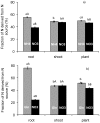Patterns of plant biomass partitioning depend on nitrogen source
- PMID: 21544211
- PMCID: PMC3081341
- DOI: 10.1371/journal.pone.0019211
Patterns of plant biomass partitioning depend on nitrogen source
Abstract
Nitrogen (N) availability is a strong determinant of plant biomass partitioning, but the role of different N sources in this process is unknown. Plants inhabiting low productivity ecosystems typically partition a large share of total biomass to belowground structures. In these systems, organic N may often dominate plant available N. With increasing productivity, plant biomass partitioning shifts to aboveground structures, along with a shift in available N to inorganic forms of N. We tested the hypothesis that the form of N taken up by plants is an important determinant of plant biomass partitioning by cultivating Arabidopsis thaliana on different N source mixtures. Plants grown on different N mixtures were similar in size, but those supplied with organic N displayed a significantly greater root fraction. ¹⁵N labelling suggested that, in this case, a larger share of absorbed organic N was retained in roots and split-root experiments suggested this may depend on a direct incorporation of absorbed amino acid N into roots. These results suggest the form of N acquired affects plant biomass partitioning and adds new information on the interaction between N and biomass partitioning in plants.
Conflict of interest statement
Figures




References
-
- Marschner H. Mineral Nutrition of Higher Plants (2nd edn) Academic Press; 1995.
-
- Hodge A. Root decisions. Plant Cell Environ. 2009;32:628–640. - PubMed
-
- Brouwer R. Nutritive influences on the distribution of dry matter in the plant. Neth J Agr Sci. 1962;10:399–408.
-
- Chapin FS., III The mineral nutrition of wild plants. Ann Rev Ecol Syst. 1980;11:233–260.
-
- Levin SA, Mooney HA, Field C. The dependence of plant root∶shoot ratios on internal nitrogen concentration. Ann Bot. 1989;64:71–75.
Publication types
MeSH terms
Substances
LinkOut - more resources
Full Text Sources

